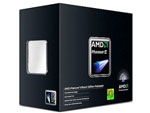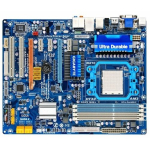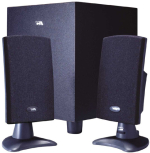System Buyers' Guide: PCs for Under $1000
by Sean Hollister on February 12, 2010 2:00 AM EST- Posted in
- Guides
AMD Mainstream PC
To be completely honest, the AMD Phenom II X3 720 Black Edition is not quite the equal of Intel's Core i3-530. In our tests, it came in slightly behind in practically every single benchmark, regardless of how many threads the applications used. But it comes very close, and if you buy into the value-packed AM3 platform using the X3 720 as your entry point, you'll have plenty of other features to go along with it.
| AMD Mainstream System | ||
| Hardware | Component | Price |
| Processor | AMD Phenom II X3 720 BE Heka (Tri-core 2.8GHz, 45nm, 3x512KB L2, 6MB L3) |
$125 |
| Cooling | CPU Retail HSF | $0 |
| Video | PowerColor Radeon HD 4850 512MB | $100 |
| Motherboard | Gigabyte GA-MA790XT-UD4P AM3 (before $15 Rebate) | $105 |
| Memory | G.Skill Ripjaws 4GB DDR3-1600 F3-12800CL9D-4GBRL | $105 |
| Hard Drive | WD Caviar Blue 500GB WD5000AAKS | $54 |
| Optical Drive | Sony Optiarc Model AD-7240S-OB 24X DVDRW SATA | $28 |
| Audio | Onboard | $0 |
| Case | Cooler Master Centurion 5 CAC-T05-UW Mid Tower ATX | $55 |
| Power Supply | OCZ ModXStream Pro 500W ATX12V SLI Certified, CrossFire Ready, 80 PLUS Certified Modular Active PFC (before $25 Rebate) | $65 |
| Base System Total | $637 | |
| Display | ASUS VH226H Black 21.5" 2ms(GTG) HDMI Widescreen 16:9 LCD (1920x1080) (before $20 Rebate) | $170 |
| Speakers | Cyber Acoustics CA-3090 26W 2.1 Speakers | $21 |
| Input | Microsoft B2L-00045 Comfort Curve Black USB Keyboard and Optical USB Mouse - OEM | $22 |
| Operating System | Microsoft Windows 7 Home Premium OEM 1-Pack (for System Builders) | $105 |
| Complete System Bottom Line | $955 | |
| Plus Estimated Shipping (within Continental U.S.) | $997 | |
| Rebates | -$60 | |
| Bottom Line (less tax, if applicable) | $937 | |
 |
Besides, when you judge it on its own merits, the $125 2.8GHz Phenom II X3 720 Heka Black Edition is still a very promising processor. Like the Athlon II X3 435 Rana we recommended for our entry-level box, the 720 Heka is at the sweet spot between dual- and quad-cores in AMD's lineup, performing better than Athlon II X4s in benchmarks that favor fewer threads and better than Phenom II X2s in benchmarks that favor more. It's a powerful overclocker, capable of a stable 3.8GHz on air and up to 3.3GHz on stock voltage, and the Black Edition suffix means you'll have an unlocked multiplier to help you get there. And of course, as with any AMD tri-core, you have a chance of unlocking its hidden fourth core with ACC. If you don't see yourself doing a lot of multitasking or multithreaded work, you could easily shave $34 by going with the $91 Phenom II X2 550 BE instead; if you plan on doing 3D rendering and video editing all day, you'd can save $23 by purchasing the $102 Athlon II X4 630 Propus. But if you're not certain where your CPU might take you and you want to maximize the possibilities, the 720 Heka is the right chip at the right price.
 |
And to house that chip, we've got not one but two bang-for-the-buck motherboard possibilities from Gigabyte. If you're not planning to buy a discrete GPU to power video and gaming, we recommend the GA-MA790GPT-UD3H, a full-sized ATX motherboard built around the 790GX / SB750 chipset. At the excellent price of only $90 after rebate ($105 without) the MA790GPT-UD3H features an onboard Radeon HD 3300 IGP with 128MB of DDR3 sideport memory, which beats both AMD's newer 785G and the Intel Core i3-530's Intel HD Graphics in terms of raw power. It also comes with Realtek's premium ALC889A 7.1 channel HD audio chipset and loads of opportunities for expansion.
The SB750 Southbridge provides the standard four flavors of RAID (0/1/5/10) across six SATA 3GB/s ports, four facing front; connectivity includes VGA, DVI and HDMI video-out, six USB 2.0, one 1394a, a combo PS/2, Realtek 8111C GbE, six audio ports and a separate S/PDIF optical out on the rear panel; and the board supports all current Athlon II and Phenom II processors along with 16GB of DDR3-1666 memory in four banks. The board's layout leaves something to be desired, with one of three fan headers and its three USB 2.0 headers sandwiched haphazardly amongst the PCIe slots, but it does include a pair of PCIe x16 slots (with 8 lanes for each in CrossFire), three PCIe x1 and a pair of PCI slots, in addition to an IDE header, two 1394a headers and a legacy floppy connector.
However, if you do plan to buy a discrete GPU, we'd recommend the Gigabyte GA-MA790XT-UD4P instead. For the same $90 after rebate, it loses the onboard video of the 790GX series but gains the newer Realtek 8111DL NIC for Gigabit Ethernet, one 1394b port and one coaxial S/PDIF port on the rear panel. It has a more sensible layout and a reputation for moderate overclocking that should serve you well if you decide to push that tri-core CPU to its full potential.
 |
As with our Mainstream Intel PC, onboard graphics make even a $100 discrete video card optional, but it's somewhat more of a talking point when that 790GX graphics still doesn't allow bitstreaming of Dolby TrueHD and DTS-HD or 8-channel LPCM audio output over HDMI. Though the Radeon 4850 is our go-to budget gaming choice at $100, if you're looking for this AMD PC to pull double duty as a home theater box, you might want to consider a Radeon 5000 series card like the $100 Radeon HD 5670 instead.










86 Comments
View All Comments
jstall - Tuesday, February 16, 2010 - link
While I have no problems with Dell LCD monitors (some great buys and I own 2) I would never again purchase a Dell system. Poor build quality, poor components and limited life. I would rather take the extra time and effort to build a system knowing the parts were carefully chosen/thought out and well put together.
Just because it's a budget system doesn't mean you can't think and act like it's a high end system when you put it together. After all, this may be someone else's high end system when it's built.
StormyParis - Friday, February 12, 2010 - link
Thanks for yet another very nice write up. I use them regularly when recommending or buying PCs.A few suggestions:
1- the perfomance graphs are very nice. Could you possibly
1a- generalize them, so that we can see how much the extra money spent going from "entry" to "mainstream" buys us, performance-wise ?
1b- indeed, include your past recommended configs, so that we can judge if upgrading is worth it.
1c- format the graphs as indexes, I got a headache mentally flipping half of the bars.
1d- to make up for all that extra work, methinks you could get rid of a handful of benches, and just keep 1 each of: boot+launch apps, DX9 game, DX10 game, video encode, office work.
2- You seem in love with Asus MBs. I've given up on them after a couple of dead MBs, and very bad service. My retailer told me that the issue was frequent, on top of that. I do like Asus's screens a lot though, much better build than most others.
3- It would be nice to have upgrade suggestions, as in "how to best spend an extra 10%"
4- Maybe you could list the peripherals (screen, kb+mouse, printer...) separately ?
Anywyay, those are minor remarks. Thanks and congrats on a job well done.
Olivier
JarredWalton - Friday, February 12, 2010 - link
Thanks for the feedback.Are you referring to ASUS or ASRock? We've got one ASUS, two ASRock (a split off from ASUS back in the day, but I'm sure we can all agree that they're not the same sort of company, given the sometimes quirky nature of ASRock board layouts), and one Gigabyte. So one of four is hardly too many ASUS boards.
All manufacturers have some poor products, and most of these recommendations are made with input from our other editors. The ASRock H55 board for example is the best current bang-for-the-buck that Raja has tested. General statements about ASUS quality (or any other brand) being good or bad don't help unless you've had actual experience with the recommended board.
For upgrades, we've got page six... though I suppose we didn't specifically address the 10% extra? Separating out peripherals is something we will likely do in future guides.
GeorgeH - Friday, February 12, 2010 - link
Overall the article was well done, but there’s a lot of room for improvement in its organization.The RAM, HDD, Case, PSU, KB/Mouse, and OS are common to all builds, so it would have been good to do a first page breaking out and detailing all of those items, and to only list them once. The following page could then have been dedicated solely to unique Entry-Level components, and the one following that to unique Mainstream components (although if there were room, both Entry-Level and Mainstream on the same page would be even better.) Also slightly better highlighting (perhaps a different color or slightly larger font) of the most important totals would help immensely.
As it stands right now, it’s very difficult to get a sense of the differences between the builds without lots of clicking back and forth and/or the opening of multiple windows, meaning a lot of the (very good) information you have to offer here just gets lost in the work of trying to sift it out.
BelardA - Friday, February 12, 2010 - link
Yep... the now discontinued X2 550 (and X3 720BE) is defaulted at 3.1ghz. With air and no voltage changes... it runs like a champ with all 4 cores running and 3.4ghz. Some are hitting 3.6~3.8 without raising the voltage on the x2 550.X2 555 = 3.2ghz default clock. About $10~15 more in price.
These CPUs are usually faster for day to day operations over the X3... getting the other 2 cores up and running is a big plus.
Gigabyte boards have the BIOS setting for this... takes seconds to do.
AznBoi36 - Friday, February 12, 2010 - link
For a HTPC case, check out the Moneual Labs MonCaso 312 HTPC case.http://moneual.cafe24.com/english/sub02/sub6.htm">http://moneual.cafe24.com/english/sub02/sub6.htm
It's a beauty.
jstall - Friday, February 12, 2010 - link
Nicely done and welcome, I think we often forget that some of the systems we build are not mainstream. I may even put together the budget AMD system in the next month or two.
Thanks for a well thought out article.
JarredWalton - Friday, February 12, 2010 - link
Congrats to Sean on his pilot article for AnandTech!Just FYI, if you try to send him an email, you'll notice that it goes to me instead. I'll forward the email messages on to him short term, because we don't want to overwhelm Sean's real email with hundreds of spam messages.(After heavy filtering, I still get at least 10-15 spam messages per day... and when we switched filtering a few years back and didn't have anything for a day or two, there were 2000+ messages in just one day. Ouch!) Update: We're going to see how Gmail does at filtering spam now, per Sean's request. So now you can flame him without me filtering anything. ;-)Anyway, long story short, you can either email Sean through me, or you can leave him a comment down here and we all get to see it. So welcome aboard, Sean, and good job with your first article.
coolhardware - Friday, February 12, 2010 - link
Very nice article Sean!I always enjoy seeing Anandtech put their expertise to use in creating some nice builds :-).
I was a bit worried that the entry level AMD system I put together a couple of weeks ago, http://bit.ly/b6GF9W">http://bit.ly/b6GF9W was already going to be obsolete ;-). It looks like it is holding its own though. That system was inspired by Anand's Phenom II X2 unlocking article. Any tweak/tips from other readers are greatly appreciated.
Please keep up the great work guys!
Rampage1 - Friday, February 12, 2010 - link
I'm not sure why most hardware sites segregate their reviews for processors
AMD processors
Intel processors
why not just processors?
and specify price/performance etc